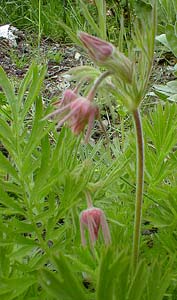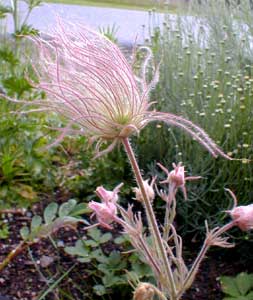
Prairie Smoke Geum; aka,
Old Man's Whiskers; aka,
Purple (or Red) Avens; aka,
Long-plumed Avens; aka,
Three-flowered Avens
Geum triflorum, a North American perennial wildflower of the rose family, is found from temperate to subarctic zones, & is common here in the Pacific Northwest east of the Cascades in British Columbia & Central Washington & along the Columbia River Gorge.
Geum roots & crushed seed pods were used by Eastern Cascades First Peoples to make a tea tonic that tastes like sassafrass. It was used by First Peoples also as an eye-wash & as a gargle for soar throat, or as a body-wash for aches & pains. Nursing women of the Blood tribe used it for sore nipples during nursing. It had many other uses, & the first white immigrants soon learned of its value. Whites brewed "Smoke Root Tea" to used for cramping during menses & for miscellaneous stomach complaints.
 It likes woodland & prairie environments, generally not extending far into desert areas, nor too far into sage country, preferring the down-side of slopes which will be relatively moist, as desert conditions go.
It likes woodland & prairie environments, generally not extending far into desert areas, nor too far into sage country, preferring the down-side of slopes which will be relatively moist, as desert conditions go.The feather-fruits (shown in the second photo) are called achenes. Though the flowers nod (as in the first photo), the stems turn upright by the time the fruit appears, so their feathery heads are a bit like troll-dolls with pink hair.
It gained the common name "Old Man's Whiskers" because of the seeds' upright feathery tufts. While I cannot recall ever having seen an old man with a pink beard, I've seen a few old ladies who appear to have had a pink hair rinse, so "Old Lady's Pink Hair" would've been more apropos.
It's also called "Prairie Smoke" for the same fluffy appearance once the clusters of maroon or plum-colored flowers have gone to seed. Foot-tall stems bear one, two, three, up to nine flowers each (but flowers in sets of three are so common it was given a species name alluding to this arrangement). The flowers nod over a six- to ten-inch mound of deeply cut leaves which are evergreen in our Puget Sound garden.
It blooms from mid-April clear through June, its peak time being extended into July by the lingering silvery-pink fluffy fruits that are at least as decorative as the blooms if not more so. However, if not in sufficient sun, it may not bloom at all.
The nodding flowers are partially closed up & bud-like, though some petals are reflexed. Bees have to force their way into the bloom with quite an aggressive action that results in pollinization. Once pollinated, the bowed heads then slowly raise themselves upward while turning into tufted fruits. The process is quite slow, so that each nodding flower lasts for weeks.
The seedheads can be picked with stems & hung upside-down in a warm dry location until they are ready for dry-flower arrangements.
As a garden ornamental it is easily lost because it remains so short, & the half-bud blooms & furry achenes are more interesting than they are showy or pretty. It uses up a lot of energy flowering so that even the leaves look a bit feeble through the rest of summer.
Come autumn, when many perennials that outshined through much of the year are dying back for the winter, this wild geum builds itself up to a ferny evergreen clump of bright green, as shown in the late September foliage photo. Some years, late in autumn, the leaves turn red, burgundy, & orange, with lasting color-interest for winter, but other years it remains a green through winter, lending the winter garden its ferny texture but in full sun where actual fearns would not survive.
In the garden they are tender during their first year, especially in our moist microclimate outside its inland prairie conditions; & they do not bloom until their second year. If they make it to maturity, however, they are hardy in their second year & for years thereafter, blooming increasingly well with each spring & summer.
Seeds are ready to germinate as soon as they are ripe, but store well for up to two years, & if gathered for later sewing will be no problem held until the following spring. Propagation is from seeds sewn unstratified in autumn or stratified in spring, or by clump division in autumn or early spring. It will colonize its immediate area by means of rhizomes.
Despite a capacity for self-seeding, geum is not highly competitive or aggressive in the garden. It needs weeds kept away from seedlings, & shouldn't have too many larger things nearby depriving it of light. Its unaggressive nature means it has become a rare wildflower over much of its range, out-competed by naturalized invaders.
It does not need a lot of water but neither is it wholly drought tolerant; it wants full sun yet may suffer in the hottest days of summer. As its name "Prairie Smoke" implies it is common in grasslands & meadows where it is apt to experience by turns wetland conditions in spring followed by temperate summer drought; this actually makes it a good companion plant for numerous bulbs so that Geum will remain to fill an area where bulbs have died back. Geum likes conditions similar to those for our native camas flowers & blue-eyed widowgrass (a primitive lily).